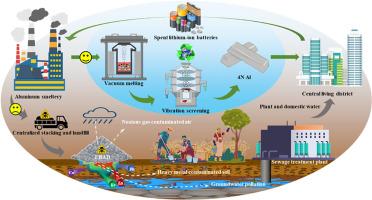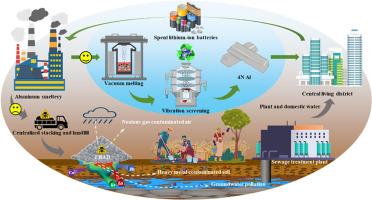真空熔炼-振动筛分从锂离子电池铝渣中高效提取铝
IF 10
1区 环境科学与生态学
Q1 ENGINEERING, ENVIRONMENTAL
引用次数: 0
摘要
锂离子电池铝渣(LBAD)由于其危害性,在储存、填埋和回收过程中对生态系统具有潜在的危害,因此具有重大的环境风险。本文介绍了一种新的方法——真空熔炼-振动筛分(VM-VS),以有效地回收锂离子电池退役过程中产生的LBAD中的Al。VM结果表明,Al形成为金属熔体,没有发生化学转化和物理挥发,可直接从LBAD(88%)中提取纯度为99.99%的Al。相比之下,挥发性杂质,如Zn、Na、as和Pb,通过固气相变和随后的蒸发被有效地去除(高达99.99%)。难处理杂质,包括Fe、Cu和Ni,表现出与Al相似的行为,并被浓缩在最终残渣中,实现了99%的回收效率。基于粒度和体积重量的VS显示较大的Al颗粒留在上层,而中、细杂质分别被分离到中层和下层。最终,99.99%的纯铝通过物理重熔和结晶分离为金属块。这种有前景的方法不仅可以实现LBAD的环境安全处置,而且可以确保可持续Al资源的有效回收。本文章由计算机程序翻译,如有差异,请以英文原文为准。


Efficient physical extraction of Al from Li-ion battery Al dross using vacuum melting-vibration screening
Li-ion battery Al dross (LBAD) poses significant environmental risks due to its hazard, with potential harm to the ecosystems during storage, landfilling and recycling processes. This study introduces a novel method (Vacuum melting-Vibration screening (VM-VS)) to efficiently recover Al from LBAD generated during the decommissioning of Li-ion batteries. VM results indicated that Al formed to metallic melt, without chemical transformations and physical volatilization, and extracted Al (99.99 % purity) directly from LBAD (88 %). In contrast, the behavior of volatile impurities such as Zn, Na, As, and Pb, were efficiently removed (up to 99.99 %) through solid-gas phase transitions and subsequent evaporation. Refractory impurities, including Fe, Cu, and Ni, exhibited behavior similar to Al and were concentrated in the final residue, achieving a recycling efficiency of 99 %. VS based on particle size and volumetric weight revealed that larger Al particles remained on the upper layer, while medium and fine impurities were separated into the middle and lower layers, respectively. Ultimately, 99.99 % pure Al was isolated as metal blocks through physical remelting and crystallization. This promising method not only enables the environmentally safe disposal of LBAD but also ensures the efficient recovery of sustainable Al resources.
求助全文
通过发布文献求助,成功后即可免费获取论文全文。
去求助
来源期刊

Journal of Cleaner Production
环境科学-工程:环境
CiteScore
20.40
自引率
9.00%
发文量
4720
审稿时长
111 days
期刊介绍:
The Journal of Cleaner Production is an international, transdisciplinary journal that addresses and discusses theoretical and practical Cleaner Production, Environmental, and Sustainability issues. It aims to help societies become more sustainable by focusing on the concept of 'Cleaner Production', which aims at preventing waste production and increasing efficiencies in energy, water, resources, and human capital use. The journal serves as a platform for corporations, governments, education institutions, regions, and societies to engage in discussions and research related to Cleaner Production, environmental, and sustainability practices.
 求助内容:
求助内容: 应助结果提醒方式:
应助结果提醒方式:


